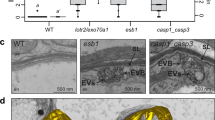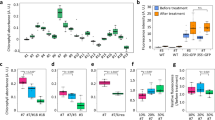Abstract
PLANT root meristems are a readily available source of mitotic cells which are ideal for cytological examination on account of their large size, high mitotic index and, in selected cases, small number of fairly large chromosomes. The root tip, in which the meristem is found, can be easily handled for experimental studies such as those on the uptake and distribution of phosphorus-32 relative to the mitotic cycle1; or it can be used as a concentrated source of cell components such as nuclei2 or cytoplasmic granules3. In general, the cells are studied after they have been fixed and subjected to some technique designed to render them clearly visible with a microscope. Such methods include embedding and sectioning, or treatment with hot acid, either normal hydrochloric or 45 per cent acetic, to weaken or remove the intercellular cement so that whole cells may be examined separately. Plant mitochondria, however, are extremely delicate and are destroyed by the fat solvents used in the process of embedding in paraffin wax and by the acids employed to remove the intercellular cement. The destruction of the mitochondria allows material which, in life, is localized on these bodies to diffuse about the cell, giving rise to serious artefacts. Thus the diffusion of ascorbic acid on to the chromosomes following the breakdown of the mitochondria has been reported4, and it is likely that other acidic substances, if originally localized on cytoplasmic granules, could be similarly redistributed5.
This is a preview of subscription content, access via your institution
Access options
Subscribe to this journal
Receive 51 print issues and online access
$199.00 per year
only $3.90 per issue
Buy this article
- Purchase on Springer Link
- Instant access to full article PDF
Prices may be subject to local taxes which are calculated during checkout
Similar content being viewed by others
References
Howard, A., and Pelc, S. R., Exp. Cell Res., 2, 178 (1950).
Brown, R., Nature, 168, 941 (1951).
Chayen, J., Symposia of the Soc. for Exp. Biol., 6, 290 (1952).
Chayen, J., Int. Rev. Cytol. (in the press).
Bell, L. G. E. (in preparation).
Chayen, J., Nature, 164, 930 (1949).
Author information
Authors and Affiliations
Rights and permissions
About this article
Cite this article
CHAYEN, J. Pectinase Technique for Isolating Plant Cells. Nature 170, 1070–1072 (1952). https://doi.org/10.1038/1701070a0
Issue Date:
DOI: https://doi.org/10.1038/1701070a0
This article is cited by
-
Removal of Apple Leaf Cuticle by Pectinase to reveal the Mycelium of Venturia inaequalis (Cooke) Wint.
Nature (1962)
-
Isolation of Tobacco Leaf Cells Capable of Supporting Virus Multiplication
Nature (1959)
-
Chromatin extrusion and DNA transfer during microsporogenesis
Chromosoma (1959)
-
Cytoplasmic Localization of Nucleic Acids in Plant Cells
Nature (1953)
Comments
By submitting a comment you agree to abide by our Terms and Community Guidelines. If you find something abusive or that does not comply with our terms or guidelines please flag it as inappropriate.



